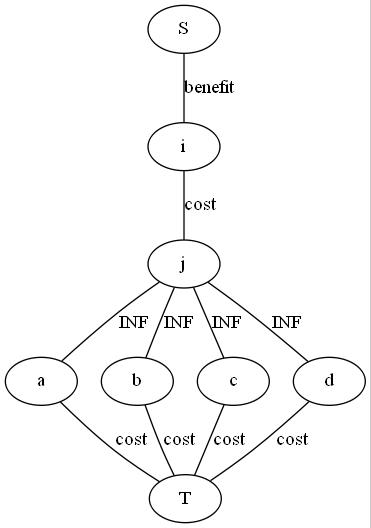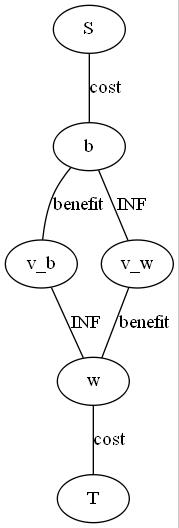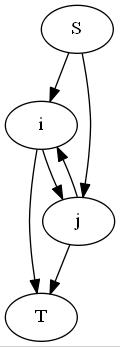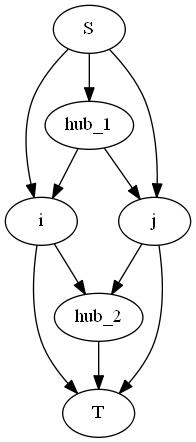相关链接
题目传送门:http://uoj.ac/problem/77
神犇题解:http://www.cnblogs.com/geng4512/p/5296863.html
解题报告
我们发现如果忽略\(1<j<i\)这个限制,再假设\({l_i} = {r_i}\)
这样的话,直接上最小割就好
现在考虑\({l_i} < {r_i}\)
这样的话,用线段树优化建图就可以啦!
再考虑\(1<j<i\)这个限制
这样的话,用函数式线段树就可以啦!
感觉是VFK强行套数据结构啊!
另外还有BZOJ 3218可以双倍经验!
话说BZOJ上那些\(200ms+\)的神犇都是用的什么算法啊?
怎么这么快啊!

Code
#include<bits/stdc++.h>
using namespace std;
const int N = 200000+9;
const int M = 2000000;
const int INF = 1000000000;
int n,m,S,T,vout,head[N],nxt[M],to[M],flow[M];
int tot,_hash[N],A[N],W[N],B[N],LL[N],RR[N],P[N];
inline int read() {
char c=getchar(); int f=1,ret=0;
while (c<'0'||c>'9') {if(c=='-')f=-1;c=getchar();}
while (c<='9'&&c>='0') {ret=ret*10+c-'0';c=getchar();}
return ret * f;
}
inline void Add_Edge(int u, int v, int f = INF, int t = 0) {
static int E = 1; vout += f * t;
to[++E] = v; nxt[E] = head[u]; head[u] = E; flow[E] = f;
to[++E] = u; nxt[E] = head[v]; head[v] = E; flow[E] = 0;
}
class Network_Flow{
int cur[N],dis[N];
queue<int> que;
public:
inline int MaxFlow() {
int ret = 0;
while (BFS()) {
memcpy(cur, head, sizeof(head));
ret += DFS(S, INF);
}
return ret;
}
private:
inline bool BFS() {
memset(dis,60,sizeof(dis));
que.push(S); dis[S] = 0;
while (!que.empty()) {
int w = que.front(); que.pop();
for (int i=head[w];i;i=nxt[i]) {
if (dis[to[i]] > INF && flow[i]) {
dis[to[i]] = dis[w] + 1;
que.push(to[i]);
}
}
}
return dis[T] < INF;
}
int DFS(int w, int f) {
if (w == T) return f;
else {
int ret = 0;
for (int tmp,&i=cur[w];i;i=nxt[i]) {
if (dis[to[i]] == dis[w] + 1 && flow[i]) {
tmp = DFS(to[i], min(f, flow[i]));
flow[i] -= tmp; flow[i^1] += tmp;
f -= tmp; ret += tmp;
if (!f) break;
}
}
return ret;
}
}
}Dinic;
namespace Persistent_Segment_Tree{
#define PST Persistent_Segment_Tree
int ch[N][2],root[N],cnt,pur,sur,L,R;
void insert(int p, int &w, int l, int r, int f = 0) {
if (w = ++cnt, p) {
ch[w][0] = ch[p][0];
ch[w][1] = ch[p][1];
Add_Edge(p, w);
}
if (f) Add_Edge(w, f);
if (l < r) {
int mid = l + r + 1 >> 1;
if (pur < mid) insert(ch[p][0], ch[w][0], l, mid-1, w);
else insert(ch[p][1], ch[w][1], mid, r, w);
} else Add_Edge(sur, w);
}
inline void insert(int p, int v) {
pur = v; sur = p;
insert(root[p-1], root[p], 1, tot);
}
void modify(int w, int l, int r) {
if (!w) return;
else if (L <= l && r <= R) Add_Edge(w, pur);
else {
int mid = l + r + 1 >> 1;
if (L < mid) modify(ch[w][0], l, mid-1);
if (mid <= R) modify(ch[w][1], mid, r);
}
}
inline void modify(int p, int node, int l, int r) {
pur = node; L = l; R = r;
modify(root[p], 1, tot);
}
};
int main() {
n = read(); PST::cnt = n << 1;
S = 0; T = N - 1;
for (int i=1;i<=n;i++) {
_hash[++tot] = A[i] = read();
B[i] = read();
W[i] = read();
_hash[++tot] = LL[i] = read();
_hash[++tot] = RR[i] = read();
P[i] = read();
}
sort(_hash+1, _hash+1+tot);
tot = unique(_hash+1, _hash+1+tot) - _hash - 1;
for (int i=1;i<=n;i++) {
A[i] = lower_bound(_hash+1, _hash+1+tot, A[i]) - _hash;
LL[i] = lower_bound(_hash+1, _hash+1+tot, LL[i]) - _hash;
RR[i] = lower_bound(_hash+1, _hash+1+tot, RR[i]) - _hash;
}
for (int i=1,l,r;i<=n;i++) {
PST::insert(i, A[i]);
Add_Edge(i, T, B[i], 1);
Add_Edge(S, i, W[i], 1);
PST::modify(i-1, i+n, LL[i], RR[i]);
Add_Edge(i+n, i, P[i]);
}
printf("%d\n",vout-Dinic.MaxFlow());
return 0;
}







